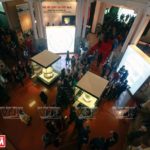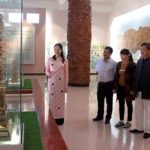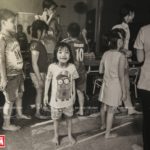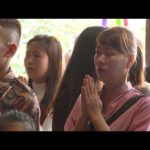Nguyen Sang, a renowned painter, has made significant contributions to modern Vietnamese painting. He is hailed as a master of the realist art movement, and is one of the four iconic Vietnamese artists of the 20th century, along with Nguyen Tu Nghiem, Duong Bich Lien, and Bui Xuan Phai. To commemorate the 100th anniversary of Nguyen Sang’s birth (August 1, 1923 – August 1, 2023), the Vietnam Museum of Fine Arts, in collaboration with the Vietnam Fine Arts Association, organized a talk show to reveal lesser-known stories about the artist.
The ‘father’ of two national treasures
Nguyen Sang was born on August 1, 1923, in the city of My Tho, Tien Giang province. In 1938, he enrolled in the École des Beaux-Arts de l’Indochine. In August 1945, he joined the revolutionary movement in Hanoi. At the end of December 1946, he went to the Viet Bac war zone to fight in the national resistance war, using his drawings as a powerful medium.
| The painting Party Admission Ceremony in Dien Bien Phu is displayed at the Vietnam Museum of Fine Arts. |
Nguyen Sang’s name and career have been honored with prestigious titles, including the Ho Chi Minh Prize for Literature and Art in 1996. Additionally, his lacquer works called ‘Ket nap Dang o Dien Bien Phu’ (Party Admission Ceremony in Dien Bien Phu) and ‘Thanh nien thanh dong’ (Strong Will of Youth) were recognized as National Treasures in 2013 and 2017, respectively. Moreover, a street in his hometown of My Tho is named after him.
Nguyen Sang is regarded as a master of realistic art. Critic Do Lai Thuy once described his portraits as a true reflection of reality, with each one being a mirror. According to Thuy, Nguyen Sang not only followed the path of realism, but also incorporated elements of expressionism and cubism to depict the truth in a unique way.
During a seminar held at the Vietnam Museum of Fine Arts on July 29, painter Luong Xuan Doan, President of the Vietnam Fine Arts Association, highlighted the realism in Nguyen Sang’s paintings, particularly evident in the two works recognized as national treasures. Doan praised the epic quality of Nguyen Sang’s lacquer painting ‘Party Admission Ceremony’ in Dien Bien Phu, which showcases a strong form, tight composition, and warm colors. He also noted that the work ‘Strong Will of Youth’ reflects Nguyen Sang’s deep longing for his southern homeland and his strong anti-American sentiments.
| Young woman and Lotus by Nguyen Sang. |
Luong Xuan Doan emphasized that Nguyen Sang’s artworks immortalize the image of brave soldiers in realistic art. Through his paintings, this image is preserved for future generations. Expressing his love for Hanoi, Nguyen Sang, who was originally from the South, studied and participated in the revolution in the city. He considered his only exhibition at the Vietnam Fine Arts Museum in Hanoi as his second birthday, and credited painter Dang Thi Khue for organizing the exhibition. Khue, a close friend of Nguyen Sang, remembers the artist’s words at the exhibition’s opening in 1984: “I have nothing but a heart and two empty hands.” The exhibition highlighted more than 100 unique works, showcasing Nguyen Sang’s peak achievements in professional creativity.
| The daughter of painter Dang Thi Khue wears the ao dai that Khue once wore in Nguyen Sang’s exhibition. Photo: Thuy Linh/The Hanoi Times |
Nguyen Sang’s exhibition marked a turning point in his life. He subsequently moved back to the South. Dang Thi Khue recalls how the artist developed a deep love for Hanoi after the exhibition. Khue, who wore traditional attire (ao dai) at the opening of the exhibition, symbolizing her nostalgia for the North, Hanoi, and her late husband, reflects on their short-lived relationship. She tearfully recounts Nguyen Sang’s words to her, saying, “You should wear ao dai and stand beside me on the exhibition’s opening day.” Khue’s daughter later wore the same ao dai at the museum, paying tribute to her mother’s connection with Nguyen Sang.
Artist Dang Thi Khue believes that the more than 100 artworks showcased in the exhibition provide evidence of Nguyen Sang’s artistic prowess, his commitment to revolutionary art, and his unique creative personality in the field of fine arts. She asserts that Nguyen Sang’s creative legacy and personality will forever remain a vital part of Vietnamese contemporary art history.
National treasures need adequate preservation work
Since 2012, around 20 artifacts have been recognized as national treasures every year. They are original and unique which have special values in life. However, not all the national treasures have received adequate preservation efforts. Behind the honor of the treasures, there are many challenges in preserving and promoting their values.


.jpg)









